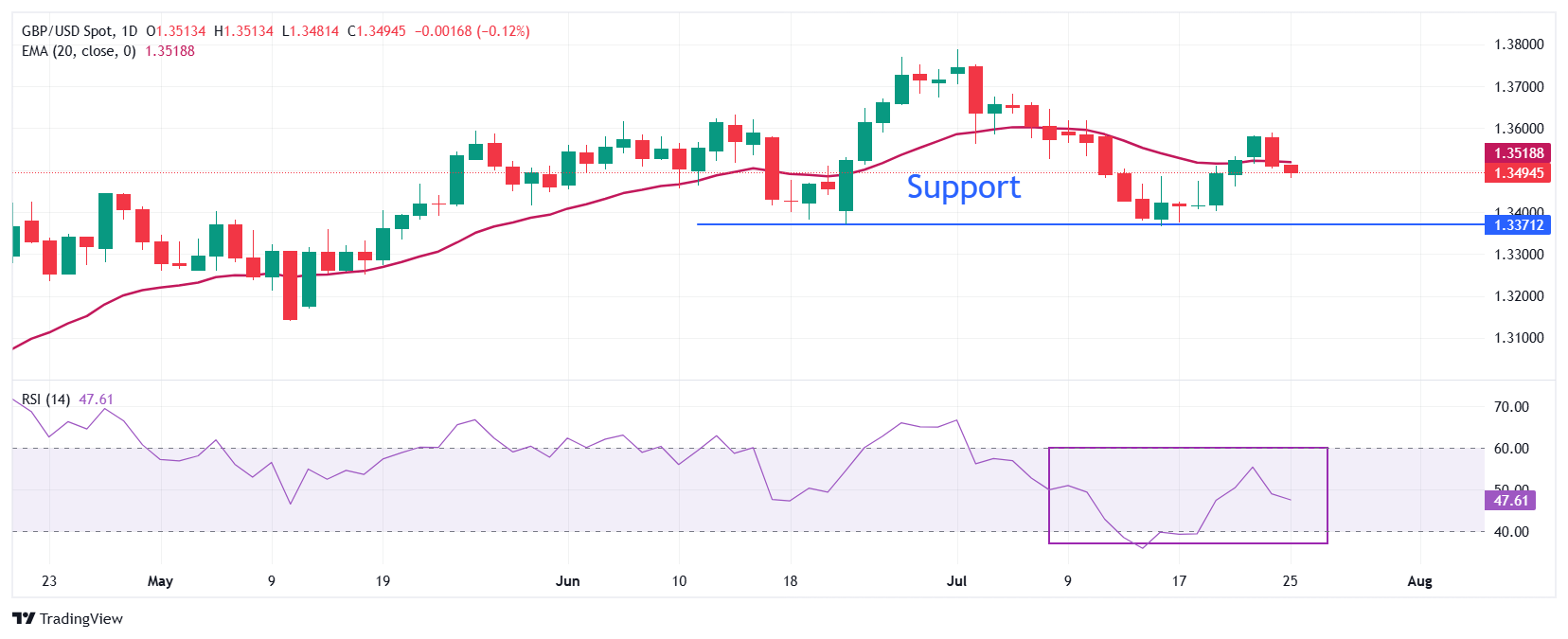Pound Sterling slumps as UK Retail Sales missed estimates
- The Pound Sterling faces selling pressure against its major peers as the UK Retail Sales rose at a slower-than-expected pace.
- The UK signs a Free Trade Agreement deal with India, which was a part of the Labour Party’s manifesto.
- Investors await key US data and the Fed’s monetary policy decision next week.
The Pound Sterling (GBP) weakens against its major peers on Friday as the United Kingdom (UK) Office for National Statistics (ONS) has reported that Retail Sales grew at a slower-than-projected pace in June.
The report showed that Retail Sales, a key measure of consumer spending, rose 0.9% month-over-month, slower than the estimates 1.2%. In May, the consumer spending measure declined by 2.7%. On year, the Retail Sales grew by 1.7%, missing estimates of 1.8% by a slight margin.
Strong demand for automotive fuel and higher sales receipts at departmental stores led to higher Retail Sales. However, sales at other non-food stores declined significantly.
Meanwhile, a slowdown in the UK private sector activity due to global trade uncertainty and a moderate hiring trend is expected to keep the Pound Sterling on the back foot. Flash UK S&P Global Purchasing Managers Index (PMI) data for July, released on Thursday, showed that the overall business activity expanded moderately, with the Composite PMI at 51.0, lower than estimates of 51.9 and 52.0 in June.
Going forward, market expectations for the Bank of England’s (BoE) interest rate decision in the August meeting will be a key driver for the British currency.
On the fiscal front, the UK signed a free trade deal with India on Thursday. UK Prime Minister Keir Starmer hailed the Free Trade Agreement (FTA) with India, stating that the deal will allow London to explore opportunities in many areas, such as liquor, textiles, and automobiles. An FTA with India was also a part of the Labour Party’s manifesto.
Daily digest market movers: Pound Sterling falls below 1.3500 against US Dollar
- The Pound Sterling slides to near 1.3480 against the US Dollar (USD) during the European trading session on Friday. The GBP/USD pair declines as the US Dollar gains ground on expectations that the United States (US) will close a trade pact with the European Union (EU) soon. A report from the Financial Times (FT) showed on Wednesday that both economies are expected to reach a tariff deal. The scenario is favorable for the US Dollar and US assets, given that EU is one of the key trading partners of Washington.
- Meanwhile, Washington's increasing number of deals with its key trading partners is diminishing concerns that US President Donald Trump’s tariff policy will hit the economy significantly. This week, Trump also announced a trade agreement with Japan in which he slashed the baseline and automobile tariff rate to 15%.
- However, fears regarding tariffs accelerating inflation continue to persist. The latest US Consumer Price Index (CPI) report showed that the impact of tariffs has started feeding into prices. For fresh cues on inflation, investors will focus on Personal Consumption Expenditures Price Index (PCE) data for June and the second quarter of the year, which will be published next week.
- Going forward, the major trigger for the US Dollar will be the Federal Reserve’s (Fed) monetary policy announcement on Wednesday. According to the CME FedWatch tool, the Fed is certain to leave interest rates unchanged in the range of 4.25%-4.50%. As traders are confident that the Fed will keep borrowing rates steady, investors will pay close attention to the monetary policy statement and Fed Chair Jerome Powell’s press conference for fresh cues on the interest rate and the inflation outlook.
- In Friday’s session, investors will focus on the US Durable Goods Orders data for June, which will be published at 12:30 GMT. Economists expect fresh orders for durable goods to have declined by 10.8%.
Technical Analysis: Pound Sterling fails to hold 20-day EMA

The Pound Sterling extends its correction to near 1.3480 against the US Dollar on Friday, after failing to break above 1.3600 the previous day. The GBP/USD pair returns below the 20-day Exponential Moving Average (EMA) after a pullback move, suggesting that the near-term trend remains bearish.
The 14-day Relative Strength Index (RSI) wobbles inside the 40.00-60.00 range, indicating a sideways trend.
Looking down, the May 12 low of 1.3140 will act as a key support zone. On the upside, the July 1 high around 1.3790 will act as a key barrier.
Pound Sterling FAQs
The Pound Sterling (GBP) is the oldest currency in the world (886 AD) and the official currency of the United Kingdom. It is the fourth most traded unit for foreign exchange (FX) in the world, accounting for 12% of all transactions, averaging $630 billion a day, according to 2022 data. Its key trading pairs are GBP/USD, also known as ‘Cable’, which accounts for 11% of FX, GBP/JPY, or the ‘Dragon’ as it is known by traders (3%), and EUR/GBP (2%). The Pound Sterling is issued by the Bank of England (BoE).
The single most important factor influencing the value of the Pound Sterling is monetary policy decided by the Bank of England. The BoE bases its decisions on whether it has achieved its primary goal of “price stability” – a steady inflation rate of around 2%. Its primary tool for achieving this is the adjustment of interest rates. When inflation is too high, the BoE will try to rein it in by raising interest rates, making it more expensive for people and businesses to access credit. This is generally positive for GBP, as higher interest rates make the UK a more attractive place for global investors to park their money. When inflation falls too low it is a sign economic growth is slowing. In this scenario, the BoE will consider lowering interest rates to cheapen credit so businesses will borrow more to invest in growth-generating projects.
Data releases gauge the health of the economy and can impact the value of the Pound Sterling. Indicators such as GDP, Manufacturing and Services PMIs, and employment can all influence the direction of the GBP. A strong economy is good for Sterling. Not only does it attract more foreign investment but it may encourage the BoE to put up interest rates, which will directly strengthen GBP. Otherwise, if economic data is weak, the Pound Sterling is likely to fall.
Another significant data release for the Pound Sterling is the Trade Balance. This indicator measures the difference between what a country earns from its exports and what it spends on imports over a given period. If a country produces highly sought-after exports, its currency will benefit purely from the extra demand created from foreign buyers seeking to purchase these goods. Therefore, a positive net Trade Balance strengthens a currency and vice versa for a negative balance.


